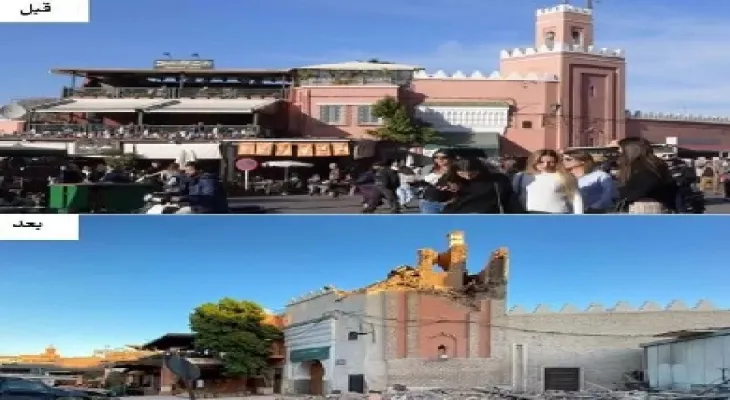Search here
Newspaper
Search here

Arab Canada News
News

Published: September 10, 2023
The earthquake that struck Morocco on Friday evening and led to the death of more than 800 people destroyed vast areas of the historic center of Marrakesh. Many residents and tourists were forced to spend the night outside, fearing aftershocks that could exacerbate the situation in the historic city, which is the closest major city to the earthquake's epicenter.
Moroccan media and local residents of the city, which is listed as a UNESCO World Heritage site, reported that some buildings collapsed in the old city, as well as parts of the city wall dating back to the medieval period.
Local television broadcast images of the collapse of the minaret of an ancient mosque and debris scattered over crushed cars.
Moroccans also shared videos showing damage to parts of the famous red walls that surround the old city of Marrakesh, built in 1071-1072, as the capital of the Almoravid dynasty and then the Almohad dynasty, referred to as "the ancient city," which is considered one of the most important tourist sites in the country.
The earthquake also caused damage to the minaret of the Koutoubia Mosque, which is one of the oldest mosques in Morocco and one of the most famous landmarks in Marrakesh.
Videos circulating showed the mosque's minaret swaying in the initial moments of the earthquake, and images published online depicted people running and screaming near the mosque.
The Koutoubia Mosque in Marrakesh is one of the most historic Moroccan mosques, built in 1147 on the ruins of an old Almoravid palace. It covers an area of 5,300 square meters, consists of 17 sections, and has 11 domes adorned with carvings, clearly showing the characteristics of Andalusian architecture.
Moroccan media reported that the mosque sustained damages, but the extent was not immediately clear. Its minaret, which stands at 69 meters (226 feet), is known as "the roof of Marrakesh."
Preliminary reports indicated that part of the minaret above the Jamaa el-Fna, a market square and tourist center, collapsed, injuring two people, before locals fled to the open area of the square in search of shelter.
Significant material damage in the area was recorded, according to eyewitness accounts and images published on social media.
Hundreds of people gathered after the earthquake in Jamaa el-Fna square and spent the night there in anticipation of aftershocks.
Debris also covered the alleys of the old Mellah Jewish quarter in downtown Marrakesh after the collapse of old buildings and the destruction of wooden roofs.
Most of the damage occurred in Marrakesh because many of the buildings are historic, and earthquakes were not taken into account during their construction.
The Islamic World Educational, Scientific and Cultural Organization (ISESCO) extended its condolences to Morocco for the victims of the earthquake.
The organization, based in Rabat, confirmed its readiness to cooperate with the relevant Moroccan authorities to address the damage caused by this earthquake, providing all necessary support in the areas of restoration and preservation of damaged historical sites in some historic cities.
Comments